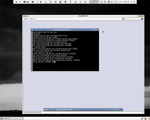Is Oracle getting ready to kill OpenSolaris?

People outside of IT seldom think of Oracle as a Linux company, but it is. Not only does Oracle encourage its customers to use its own house-brand clone of RHEL (Red Hat Enterprise Linux), Oracle Unbreakable Linux, Oracle has long used Linux internally both on its servers and on some of its desktops. So, what does a Linux company like Oracle wants to do with its newly purchased Sun's open-source operating system, OpenSolaris? The answer appears to be: "Nothing."
Sun, Oracle and third-party sources are telling me that OpenSolaris developers are afraid that they'll be either moved over to working on Linux or let go once the Sun/Oracle merger is completed. Other Sun open-source managers have expressed concern that their jobs may disappear once Oracle has acquired Sun.
This can't come as much of a surprise. Edward Screven, Oracle's Chief Corporate Architect, said last year, ""Oracle definitely runs on Linux. We have very few servers in our infrastructure that are not Linux; that support, you know, internal IT systems, very few. And even the ones that continue to exist are on a plan to be phased out. So we definitely run our business on Linux. In fact, I mean, our entire IT infrastructure is Linux, our entire development infrastructure as well. So, you know, our development platform is Oracle Enterprise Linux. Our test platform is Oracle Enterprise Linux."
-

- Login or register to post comments
 Printer-friendly version
Printer-friendly version- 1401 reads
 PDF version
PDF version
More in Tux Machines
- Highlights
- Front Page
- Latest Headlines
- Archive
- Recent comments
- All-Time Popular Stories
- Hot Topics
- New Members
digiKam 7.7.0 is released
After three months of active maintenance and another bug triage, the digiKam team is proud to present version 7.7.0 of its open source digital photo manager. See below the list of most important features coming with this release.
|
Dilution and Misuse of the "Linux" Brand
|
Samsung, Red Hat to Work on Linux Drivers for Future Tech
The metaverse is expected to uproot system design as we know it, and Samsung is one of many hardware vendors re-imagining data center infrastructure in preparation for a parallel 3D world.
Samsung is working on new memory technologies that provide faster bandwidth inside hardware for data to travel between CPUs, storage and other computing resources. The company also announced it was partnering with Red Hat to ensure these technologies have Linux compatibility.
|
today's howtos
|









.svg_.png)
 Content (where original) is available under CC-BY-SA, copyrighted by original author/s.
Content (where original) is available under CC-BY-SA, copyrighted by original author/s.

Recent comments
1 year 11 weeks ago
1 year 11 weeks ago
1 year 11 weeks ago
1 year 11 weeks ago
1 year 11 weeks ago
1 year 11 weeks ago
1 year 11 weeks ago
1 year 11 weeks ago
1 year 11 weeks ago
1 year 11 weeks ago